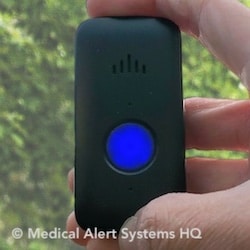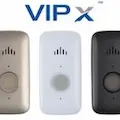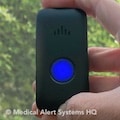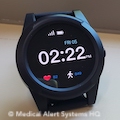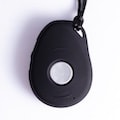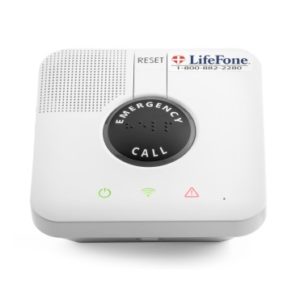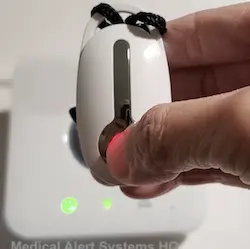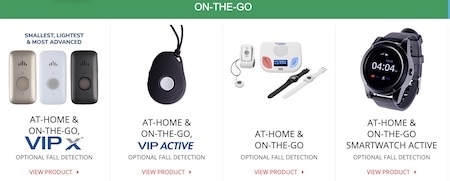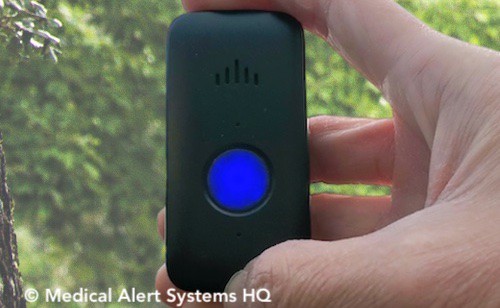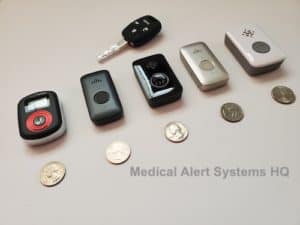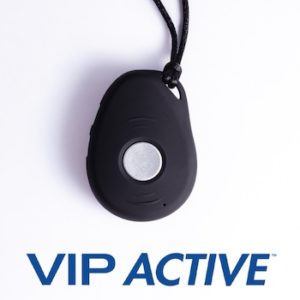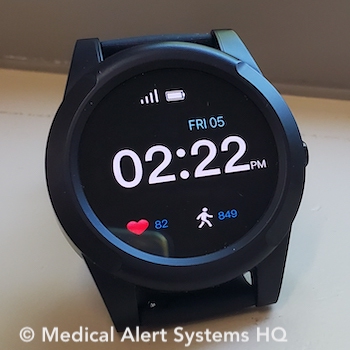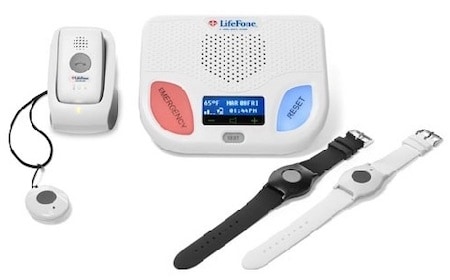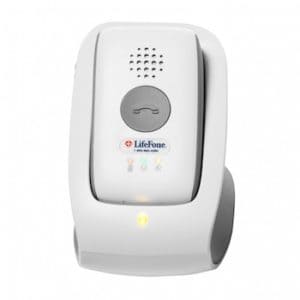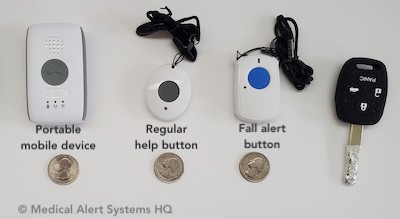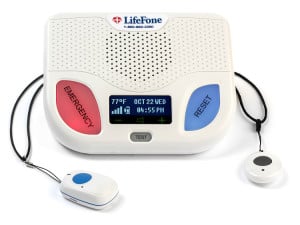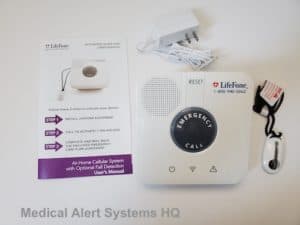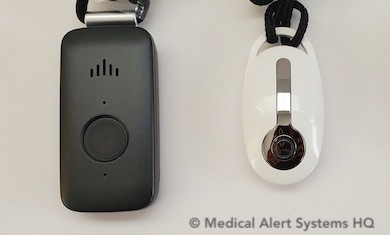Last Updated on September 13, 2023
Top Recommended!
Questions? Call toll-free 1-877-352-1292 or visit LifeFone’s Official Website
LifeFone is an established provider of medical alert systems with decades of operations experience. The company operates their own US-based, TMA (The Monitoring Association) Five-Diamond certified monitoring center. LifeFone accepts detailed personal profiles and is willing to work with each customer on a customized care plan.
My experience with LifeFone’s monitoring service has been very positive. My test calls were always promptly answered by their care agents who spoke clearly and calmly.
Their VIPx premium mobile medical alert pendant with GPS is based on the smallest mobile medical alert hardware on the market. It stands out for its quality, light weight , fast response and long battery life.
Skip ahead to Which LifeFone product is best?
Special Offer: Get 1 Free Month, Free Activation, Free Shipping & Price Lock Guarantee. With annual/ quarterly payment plans. No promo code needed, Call today 1-877-352-1292.
Disclosure: We receive referral commissions for purchases made (details).
If you are new to LifeFone, here is a quick video demonstration of my pick for the best LifeFone device. This model, the VIPx, works at home and away from home.
Questions? Call toll-free 1-877-352-1292 or visit LifeFone’s Official Website
Why these Lifefone Reviews?
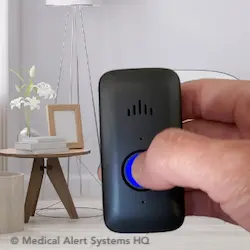
We’ve put these reviews of LifeFone’s products and services to help readers like you decide if the company is suitable for your needs. LifeFone offers several products that perform differently, so in these reviews, I have separated the products when evaluating their pros and cons. Given my background and experience (work samples) testing out products from different brands, I’ve also added comparison points for your consideration.
These LifeFone reviews are based on my original research and testing. For LifeFone’s official messaging, please visit their website here. LifeFone’s website is very informative and contains the brand’s latest information.
LifeFone Pros and Cons
Pros
Excellent Mobile Pendant – The LifeFone VIPx is based on the smallest and lightest design currently available for a mobile medical alert. The VIPx offers a super-long battery life of up to 10 days, out-performing many competitor products.
Multiple Equipment Options – Besides the VIPx, LifeFone offers a good range of systems and options to pick from.
Caregiver Tools – Customers and caregivers can access additional options such as Daily Check-in Calls, Activity Assurance, GPS Location Service, and free email/text notifications for system events.
Quality US-Based Monitoring – LifeFone runs their US-based and TMA (The Monitoring Association) Five-Diamond certified monitoring service. They have backup call centers in geographically different locations to ensure interrupted service 24/7.
No Equipment Fees – LifeFone does not charge any upfront equipment fees, not even for a premium mobile medical alert device like the VIPx. They will loan you the equipment as long as you remain a subscriber.
Customer Friendly Terms – Customers can cancel at any time and get a pro-rated refund on the unused months of any pre-paid service (upon equipment return). LifeFone also offers a 30-day money-back guarantee, something not every company offers. Their policies are listed on their website.
Stellar BBB Record – Every major medical alert company has an A+ rating, but not as many have a low number of complaints. LifeFone’s record of 2 complaints in a 3-year period is reassuring.
Cons
Online Profile Update – Although LifeFone provides customers with an online form to update their information, an online account login would make managing the process and verifying information even easier.
Higher Month-to-month Cost – For customers who pay month-to-month, LifeFone’s cost tends to be a little higher. They offer better discounts if you are willing to prepay for months ahead.
Special Offer: Get 1 Free Month, Free Activation, Free Shipping & Price Lock Guarantee. With annual/ quarterly payment plans. No promo code needed, Call today 1-877-352-1292.
Disclosure: We receive referral commissions for purchases made (details).
How it Works
LifeFone medical alert systems allow seniors and other customers to quickly connect with live monitoring operators (LifeFone Care Agents) to get the help they need. The systems come in different configurations, but each system will have an emergency help button.
In case of an emergency, the customer simply presses the button to initiate a call connection with a LifeFone Care Agent. Call connections are made through a landline or else through a cellular phone network connection, depending on the type of system selected. The system will then facilitate two-way communications between the customer and an agent.
After assessing their customer’s needs, the operator will quickly contact the appropriate party that can best help the user. Depending on the particular situation, it could be an emergency medical technician or EMT, or the senior’s family member, caregiver, or friend.
Cellular Connection
LifeFone’s non-landline medical alert systems connect through a cellular network. They come equipped with SIM cards and a working cellular connection. Whether you have a cell phone or not, it does not matter, nor will it change anything. Their products work independently from our personal cell phones or cell phone plans.
Monitoring Center
LifeFone offers certified US-based monitoring 24/7, every day of the year. LifeFone operates its own The Monitoring Association (TMA) Five-Diamond certified call center. Many companies outsource this function, but LifeFone has chosen to invest in and manage this important function internally.
According to LifeFone, their Care Agents undergo rigorous training before they are certified by LifeFone to handle emergency calls. The training curriculum covers emergency care fundamentals with a focus on the needs of seniors. In addition, LifeFone has a quality assurance program in place where calls are monitored and reviewed.
Over and above their main call center, LifeFone has arrangements in place for backup call centers, in geographically different locations. Their backup call centers adhere to high industry standards like UL and TMA Five-Diamond as well.
Their operational approach ensures quality, uninterrupted monitoring at all times, and cements LifeFone’s standing as a top-tier medical alert company.
↑↑Click on Banner Above to Visit LifeFone’s website.
My Personal Experience
My experience with LifeFone’s monitoring service has been very positive. Firstly, my test calls connected successfully each time. LifeFone’s Care Agents always answered promptly in a courteous and professional manner. They routinely checked to make sure that they were speaking with the right person and that they have the correct address on file.
While making my test calls, I checked with their monitoring center agent to make sure that they have my correct emergency contacts on file. They did. 👍 I also updated an agent directly with my lockbox code (that I thought had been submitted).
Pro-tip: With any medical alert company, their customer support and monitoring service are two separate departments. Whether its LifeFone or another company, it doesn’t hurt to check that the monitoring center agent has your emergency contacts’ info and optionally, lockbox code. This can be easily done in a “by the way” manner during a regular test call.
One last highlight, there was once my VIPx fell and triggered an automatic fall alert. Although it was a false alert, the Care Agent took the chance to let me know that my device battery level was getting low. I appreciated the extra touch and felt that the reminder was right on point.
Which LifeFone system is best?
For complete in and out-of-the-home coverage, their best system is the VIPx mobile medical alert based on my research and testing. This is because it is a small all-in-one button device that comes with a clear speaker and microphone. It offers a cellular connection (no landline tethering), fast response, long backup battery life, and optional caregiver features. Learn more.
Special Offer: Get 1 Free Month, Free Activation, Free Shipping & Price Lock Guarantee. With annual/ quarterly payment plans. No promo code needed, Call today 1-877-352-1292.
Disclosure: We receive referral commissions for purchases made (details).
Besides the VIPx, Lifefone offers other systems:
Safe Watch Active – LifeFone’s At-Home & On-the-Go Safe Watch Active is an easy-to-use digital watch with a SOS button on the side. See review.
VIP (Voice-in-Pendant) Active – LifeFone’s VIP Active is a mobile device pendant that works at-home and on-the-go. See review.
At-Home and On-the-Go – This system is best recommended for people who primarily need in-home coverage but would also like the flexibility of having a mobile device to use on-the-go. See review.
At-Home Cellular or Landline – These are more basic systems that offer in-home coverage only. They are also less costly. See review.
Lifefone VIPx (At-Home and On-the-Go)
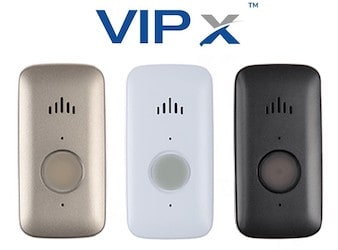
Questions? Call toll-free 1-877-352-1292 or visit LifeFone’s Official Website
LifeFone’s VIPx pendant is an all-in-one voice-in-pendant solution for both in and out-of-the-home coverage. The lightweight help pendant comes with a speaker, microphone, GPS, and 4G LTE cellular connection (Verizon or AT&T, you pick).
LifeFone VIPx – Test calls successfully connected both indoors and on-the-go outside.
Button lighted up blue when pushed.
Pros
Smaller and Lighter (1.3 oz)
At 1.3 oz (less than the weight of 7 quarter coins), VIPx customers are getting the lightest mobile pendant device on the market.
The LifeFone VIPx has a smaller profile with narrower and thinner dimensions than other similar devices (2.72 inches tall by 1.38 inches wide by 0.57 inches thick). The weight of VIPx felt minimal when I wore it with a lanyard.
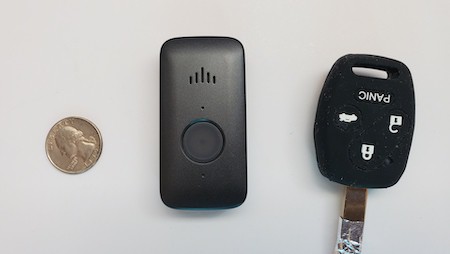
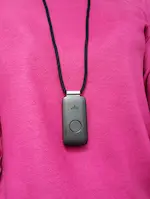
Fast Response Performance
Here is a video of a test call I made, you can see how quickly the process unfolded:
Questions? Call toll-free 1-877-352-1292 or visit LifeFone’s Official Website
The above test call took 26 seconds between a button push and a care agent answering. We performed a number of test calls and the response times averaged 30 seconds. This timing compares well with the average of 45 seconds for the industry.
Upon pushing on the button, the VIPx’s auto attendant immediately picked up and asked if I needed help (and gave me a chance to cancel the alert). I said “Yes,” and seconds later, a live operator came through the line.
The VIPx’s initial immediate response was affirmative feedback that the alert signal had been successfully received. In the past, I’ve experienced products where the button push signal did not go through on the first try (and I waited, not realizing that I needed to push the button again).
Super-long Battery Life (Up to 10 days)
According to official specifications, the VIPx has a long battery life of up to 10 days after each full charge. 10 days is a long period compared to 3 to 5 days on average for mobile alert devices offered by other medical alert companies.
Although I felt skeptical when I first heard about it, the 10-day duration tested true for me. My VIPx device was able to last beyond 16 days on a single full charge in my local area. It performed comparatively better than other mobile devices I’ve tested.
Keep in mind that battery life for these devices can drain more quickly in areas with weaker cellular coverage. My area has good cellular signals, and mobile devices tend to test true to their maximum specified levels.
Optional Caregiver App (Location & Activity Reports)
For additional indicators and metrics, LifeFone offers a companion Caregiver App (at $8/month). I added it to my subscription and found that the Caregiver App provided a lot of useful information, just as advertised, such as: the device’s location, the first motion of the day, daily steps walked, a report on button pushes, the device’s battery level, and more.
While most other mobile device apps can share device location and button push alerts, they can’t tell the timing of the first step or track daily steps walked. These are helpful activity indicators that alert us to the well-being of our loved ones.
Other Factors (Water-Resistance, Optional Fall Detection)
Although the VIPx is light in weight, it felt well-made. It is water-resistant for use in showers (IP67 water-resistance rating). I’ve placed mine by the shower several times and the water droplets and humidity did no harm. I did wipe my VIPx dry each time to keep it in good condition.
VIPx’s optional fall alert worked well in my testing and provided an extra layer of protection. That said, no fall detection technology will detect each and every fall correctly. No excessive false alerts occurred, a factor that could make the experience disruptive.
No Equipment Cost
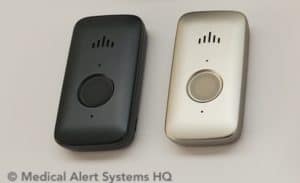
LifeFone does not require you to pay for the VIPx device, nor do they charge an activation or start-up fee.
Cons
Adding Caregiver App Reduces Battery Life to 5-day Level
One drawback with adding the Caregiver App (at $8/month) is that it will reduce the battery life to a maximum of 5 days compared to 10 days. While this may seem like a sizable decrease, a 5-day maximum period still rates and compares well. Most other top-tier mobile devices have up to 3 to 5 days of battery life.
Regardless of whether you add on their Caregiver App, LifeFone offers free email and text alerts to authorized emergency and family contacts for device events like low battery and button pushes.
Improvements over Voice-in-Pendant VIP (Predecessor)
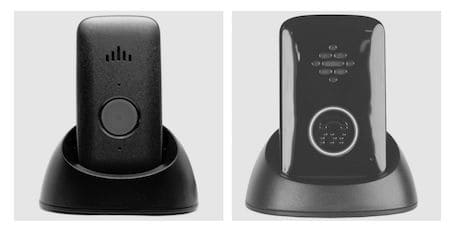
Special Offer: Get 1 Free Month, Free Activation, Free Shipping & Price Lock Guarantee. With annual/ quarterly payment plans. No promo code needed, Call today 1-877-352-1292.
Disclosure: We receive referral commissions for purchases made (details).
The VIPx is an improvement over its predecessor, the older LifeFone At-Home and On-the-Go VIP device with GPS and fall detection. Compared to its predecessor, the improvements are:
Size. VIPx is smaller and lighter. The VIPx is about 1/2 the size and 1/2 the weight (1.3 oz vs. 2.6 oz) of its predecessor, the VIP with GPS and Fall Detection.
Battery Life. VIPx offers the option for a much higher battery life, up to 5 to 10 days vs. up to 5 to 7 days for its predecessor, the VIP (with GPS and Fall Detection).
That said, there was also a lighter version of the old VIP device (1.7 oz) with a longer battery life of up to 30 days. This lighter VIP version was more limited; it had wifi and cellular triangulation location technologies, but lacked GPS, and could not do fall detection.
Optional Companion App. VIPx has a more comprehensive optional Caregivers app (add $8/mo) with real-time device location tracking and activity metrics like First Motion of the Day and steps walked.
To sum it up, the VIPx supersedes the previous VIP devices with its smaller and lighter frame, additional features, and use of Artifical Intelligence technology.
LifeFone VIPx Review Summary

The LifeFone VIPx device is best recommended for seniors who like the convenience of a single all-in-one pendant. Based on the smallest and lightest mobile medical alert device hardware, it contains everything needed to work: a help button, HD speaker, microphone and cellular connection.
Overall, the VIPx is my top recommendation for a mobile medical alert device because of its small size, quick response and extended battery life. In addition, LifeFone will lend out their equipment for free to subscribers.
Questions? Call toll-free 1-877-352-1292 or visit LifeFone’s Official Website
LifeFone VIP Active (At-Home and On-the-Go)
LifeFone offers another choice for an At-Home and On-the-Go device, the VIP Active (Voice-in-Pendant Active). This is a small, stylish, water-resistant (showerproof) emergency help button device. Similar to the VIPx, customers can push a button to access LifeFone’s 24/7 monitoring service. If you look at the photo above, the emergency help button is slightly recessed, silver, and round.
The VIP Active also contains a speaker and microphone on the VIP to facilitate two-way communication. Emergency alert calls are routed through AT&T’s cellular networks. The device works both and out of the home, as long as the cellular connectivity is good.
Comparison with LifeFone VIPx
The VIP Active offers another choice of a pendant to LifeFone customers. Here is how they compare:
A different external style. The VIP Active’s curvy alternative design sets it apart from the oblong-shaped VIPx.
Size and weight. Although the VIP Active is slightly larger and heavier (1.6 oz) than the VIPx (1.3 oz), the difference is not huge (less than 2 quarter coins’ weight).
Battery life. The VIPx has a strong battery life that is up to 5 days (with app) to 10 days (without app). The VIP Active’s battery life is up to 5 days.
Real-time device locating. VIP Active has a text-to-locate service that allows caregivers and family to query for the device’s real-time location (service is Free $0). Real-time device local querying is also available through the VIPx, using its Caregiver app (add-on $8/mo).
Cost. The VIP Active is slightly less expensive at $39.95/mo vs. $41.95/mo for the VIPx. In addition, with VIP Active, there is no extra charge for the feature to do real-time querying of location.
VIPx or VIP Active?
If you prefer how the VIP Active looks, you may want to look further into it. It’s important to choose a design we are comfortable with, as it makes us more likely to carry it with us. Another advantage of the VIP Active is that text-to-locate querying comes included at no extra cost.
In terms of specifications, the VIP Active looks good on paper. That said, as I have not tested it, I am unable to surmise how well the VIP Active will perform in real life. If this product interests you, you may want to check out the comparison points above and then contact LifeFone directly at 1-877-352-1292 to get your questions answered.
In case it helps, I have previously tested a similar model to the VIP Active, but offered through another medical alert company. I’ve compared it’s performance to LifeFone’s VIPx in this review.
If you have questions on the LifeFone Active or their other products, please contact LifeFone directly at toll-free 1-877-352-1292.
At-Home & On-the-Go Safe Watch Active
Questions? Call toll-free 1-877-352-1292 or visit LifeFone’s Official Website
LifeFone’s new At-Home & On-the-Go Safe Watch Active is a fashionable and contemporary format for a medical alert device. This smartwatch has an easy way to call for help in an emergency with the press of a button.
Although it is technically a smartwatch, it is much easier to use than the average smartwatch. You do not need to sync it with a smartphone right from the getgo. You could think of it as a digital watch with advanced features like heart rate measuring (for casual use, non-diagnostic), steps counting and weather reports.
Questions? Call toll-free 1-877-352-1292 or visit LifeFone’s Official Website
Some of the features of this LifeFone watch to pay attention to are:
No smartphone needed. We were surprised by how easy it was to get the watch ready for use. All it took was charging it up and then pushing the side button (pictured below) to connect with a monitoring center agent.

Stylish, you have it on you everywhere. It’s a welcome alternative to wearing a neck or wrist button. Although I initially found the watch bulky, I got used to it within a day. The straps were flexible and they felt comfortable on my wrist. The watch is also lightweight and water-resistant for shower-use.
GPS Tracking. LifeFone’s Smartwatch Active features GPS tracking technology, allowing responders to locate you in an emergency.
Text-to-Locate. Family members and caregivers can also text-to-locate the device, which allows them to locate their elderly loved one quickly.
This text-to-locate feature tested well for the most part, but we experienced a particular spot where we were not able to obtain a GPS reading by text. Fortunately, we were able to ascertain that the watch’s GPS mechanism was working properly through pushing the help button to reach their monitoring center. The operator was able to provide us with the correct location.
Battery Life. Battery life is up to 24 hours on a full charge, which we were able to test and confirm. That said, battery life performance will vary depending on how you use the watch and the strength of local cellular signals. Compared to the up to 10 days level of the LifeFone VIPx, this is probably the least convenient part of using this device.
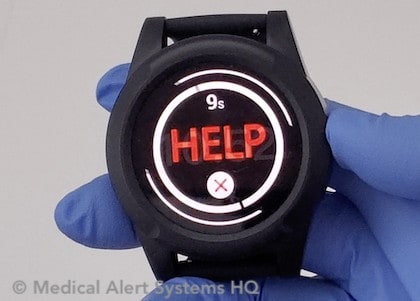
Prompt Response Times. In our testing, the response times were mostly in the band of 30 to 45 seconds. Out of 7 test calls, 6 calls were answered in times that ranged from 32 seconds to 44 seconds. This performance is comparable to other top-tier medical alert services. For more on the call process, you can watch the video above demonstrating a test call we made.
Helpful Apps. As a smartwatch, the device will also count steps, measure your heart rate* and provide weather reports through its various apps. The watch can even do fall detection as an optional feature. (*The heart rate monitoring is for informational purposes only, and not to be used for medical diagnosis.)
Our Recommendation
The LifeFone At-Home & On-the-Go Smartwatch Active is best recommended for seniors who like wearing a sleek medical alert watch over the more classic neck or wrist button format. The watch is well-made and shower-safe. It’s also very simple to get started on – just charge it and wear it.
If you have a higher budget and prefer something with even better workmanship and more frills, Medical Guardian’s MG Move would make a better choice (based on our experience, we’ve tested both hands-on).
Overall, the LifeFone Safe Watch is a good product offered by a long-established medical alert service provider. They offer certified 24/7 monitoring with the watch, with reasonable terms and no equipment fees.
At-Home and On-the-Go (“Duo”)
Questions? Call toll-free 1-877-352-1292 or visit LifeFone’s Official Website
LifeFone’s at-home and mobile system is a comprehensive option (with dual speaker units) for senior users looking to have monitoring help available both in and out of their homes.
Essentially, product users receive two systems with this “duo” configuration. You can think of it this way: you get a full at-home base unit system, which works in and of its own. In addition, you also receive a portable mobile GPS device for both in-home and on-the-go coverage.
As you can see in the photo above, the system comes with a help button (to transmit an activation signal), worn as a necklace or wristband. The button will activate an emergency call on both the base unit (up to 1300 feet range) and the portable device (up to 350 feet range).
All emergency calls are routed via AT&T’s wireless network. No home phone line is needed.
Pros
Extended Voice-Range
Both the main medical alert base unit and portable mobile unit contain a speaker and microphone to facilitate two-way communication. That allows for an extended voice-range compared to just having an at-home base unit.
I could always take the portable GPS unit with me while in the bathroom or out at the patio at home or in my purse while driving and doing shopping. That ensures that I will always be able to speak with the LifeFone agent.
Continued Coverage While Recharging
When I leave my portable unit on the charging dock to recharge, I can continue to wear the smaller necklace help button. When pushed, the help button will send an alert activation signal to both my portable unit and at-home base unit.
With a single mobile medical device like the VIPx is left in the charger, you will need to stay within reach of the device in order to activate an alert.
Convenient Ultra-Lightweight Button
The regular help button weighs only 0.6 oz because it is just a signal transmitter. I found the button more comfortable than wearing a mobile device, even compared to the lightweight VIPx.
Cons
More Complicated
The double At-Home and On-the-Go system configuration can be harder to understand and use. You also have more equipment to be responsible for. In comparison, with the all-in-one VIPx device, all you have is one single device with an emergency call button. There’s not much to learn.
Larger Mobile Device
The At-Home and On-the-Go system’s mobile device is bulky. It is larger and heavier than LifeFone’s VIPx (1.3 oz). As a comparison, the larger device weighs 2.8 oz and may bring up greater resistance to carrying it. The difference is noticeable holding them in my palm, and I weighed both to quantify the difference further.
Comparison with LifeFone VIPx Device
Advantages of the LifeFone At-Home and On-the-go System (duo)
As mentioned, the At-Home and On-the-go System comes with two speaker and microphone units, and an ultra-lightweight button (acting like a remote control button).
With duplicated and portable in-home coverage, the mobile device can act as a backup of the at-home base unit, providing extended voice-range and reliability.
The ultra-lightweight button offers greater flexibility and comfort. It can be worn when the product user is sleeping or when the portable mobile device is charging in its charging dock.
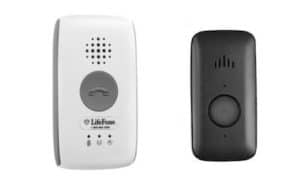
Advantages of LifeFone VIPx (all-in-one device)
The VIPx offers the advantage of being lighter than the portable mobile device of the LifeFone At-Home and On-the-go duo system. VIPx weigh 1.3 oz vs. the duo system’s larger portable mobile device at 2.8 oz.
The VIPx has a longer battery live (up to 5 to 10 days). In comparison, the portable mobile device from the LifeFone At-Home and On-the-go system will only last up to 1 day before it needs to be recharged.
For seniors who are active and on-the-go a lot, the VIPx would be more suitable since it has a smaller and lighter mobile device and longer backup battery life.
LifeFone At-Home and On-the-go Review Summary
The LifeFone At-Home and On-the-go system is best recommended for seniors who primarily require in-home coverage, and occasionally, on-the-go coverage. The system delivers extended voice range through an at-home base unit and a separate mobile unit. Product users have the option to use an ultra-lightweight help button (necklace or wristband).
If you have questions on this LifeFone At-Home and On-the-go system, please contact LifeFone directly at toll-free 1-877-352-1292.
At-Home (Cellular/ Landline)
Questions? Call toll-free 1-877-352-1292 or visit LifeFone’s Official Website
If you need in-home coverage only, LifeFone provides customers with at-home base station units that pair with a necklace or wrist button.
These at-home base station units house a loudspeaker and a highly sensitive special microphone that make clear 2-way communications between the senior client and emergency center operator possible. Size-wise, they are about the size of a phone answering machine, measuring approximately 6 inches by 6 inches by 3 inches.
Below is a video where we demonstrate how the LifeFone At-Home base unit and paired wireless help button work. You can see how the medical alert button (necklace button) wirelessly transmitted an emergency signal to the base unit, which then dialed the monitoring center.
Special Offer: Get 1 Free Month, Free Activation, Free Shipping & Price Lock Guarantee. With annual/ quarterly payment plans. No promo code needed, Call today 1-877-352-1292.
Disclosure: We receive referral commissions for purchases made (details).
Monitoring Response Performance
The above LifeFone medical alert test call was answered in a quick 32 seconds. Apart from this call, I made a number of other test calls as well. The response times ranged from under 30 seconds to over a minute, averaging out at 47 seconds. These series of test calls were made through LifeFone’s non-landline At-Home cellular base unit.
This product’s level of performance rates at about the industry average. As a comparison, the LifeFone VIPx delivered a faster 30-second average response time when I tested it.
In general, response times can vary from product to product, even when they are offered through the same brand.
Pros
LifeFone’s at-home system is a “set it and forget it” system in the sense that they are continuously plugged into a power source. They only stop working when there is a power loss. You do not need to recharge it frequently.
The necklace button weighs about 0.6 oz. It’s very light because it does not contain a speaker and microphone. In comparison, LifeFone’s VIPx button weighs 1.3 oz, and it uses the lightest “voice-in-pendant” mobile device hardware available on the market today.
Both Cellular and Landline versions available.The base unit we demonstrated above is the no-landline-needed version that comes fitted with an AT&T 4G cellular network connection. LifeFone also offers a landline version that looks the same and connects calls through a landline.
Cons
At-Home coverage only. The system is only meant for in-home use. Help will only be sent to your home, not to wherever you are pushing the button from (regardless of the long button range of up to 1300 feet specified).
Backup battery life. During the review, my At-Home cellular test unit’s backup battery appeared too weak to be functioning normally. As such, I am unable to report on its performance level. You can contact LifeFone at 1-877-352-1292 to learn more and then test it out for yourself.
Backup battery power is important because should there be a power loss, the at-home unit can only stay powered through its backup battery. Thus, whether you decide to get this or another similar product, I recommend that you test out its backup battery. Fortunately, LifeFone offers a 30-day money-back guarantee.
My experience testing the hardware of LifeFone’s At-Home and On-the-go‘s at-home medical alert base unit turned out much better. More next…
Comparison with Other At-Home Products
LifeFone At-Home and On-the-Go (“Duo”)
If I needed an at-home medical alert base unit through LifeFone, I would go with their At-Home and On-the-Go “duo” system. Firstly, the system’s at-home base unit backup battery tested true to the specified level of up to 30 hours (lasted up to 24 hr to 30 hr in my experience).
Secondly, this LifeFone system includes an extra mobile device for extended voice-range at home and the occasional on-the-go coverage you might require. Learn more.
Bay Alarm Medical In-Home
Looking beyond LifeFone, my top choice for an in-home medical alert is Bay Alarm Medical‘s in-home medical alert system. It tested well across different metrics. Bay Alarm Medical’s In-Home cellular system test results were better than LifeFone’s At-Home cellular in terms of response time (40 sec Bay vs. 47 sec Life), and backup battery life (25 hr Bay vs. NA Life). Learn more.
LifeFone At-Home Review Summary
The LifeFone At-Home systems provide medical alert coverage for homes. There are two versions, landline and cellular (no-landline-needed). When I pushed on the necklace help button, the LifeFone At-Home cellular system connected me to their Care Agent promptly (see video). Test calls were performed only while the system remain plugged in to a power source (backup battery notes).
For primarily at-home coverage, I recommend LifeFone’s At-Home and On-the-Go “duo” over this for just $5 more a month (see pros and cons comparison).
How Much Does Lifefone Cost?
LifeFone’s cost structure is as follows:
The monthly costs range from $29.95 per month for their at-home landline system to $45.95 per month for their VIPx at-home and on-the-go device. With annual prepayment discounts, the pricing drops to $24.95 to $41.95 per month respectively.
The company offers a 30-day money back guarantee and pro-rated refunds for unused months that were prepaid. There are no minimum term requirements. These terms are very good.
$0 Equipment Cost Explained
There are no equipment fees. Their medical alert equipment is loaned out to their subscribers for free.
No extra start-up or activation fees either.
For consumers like us, this offers a flexible approach. My money is not tied up. Let’s say I find that the model does not operate to my liking after a few months, I can freely make a switch.
However, the free use of equipment also means that we are responsible for it. Lost and damaged equipment can result in lost equipment fees (ballpark $250 to $300) and interrupted access to monitoring services.
For that, their protection plan at $5/mo will help cushion the loss and put you back on track with a new device quickly.
For more specifics, please contact LifeFone at 1-877-352-1292 to get your questions answered.
Additional Options
LifeFone offers several additional options with their products, such as:
Automatic fall detection. This is available at an additional $5/mo to $10/mo for most of their systems and devices.
Protection plan. $5/mo. Consider getting this for additional peace of mind. If the equipment or device becomes lost or damaged, it mitigates your expenses. Call 1-877-352-1292 for details.
Companion App. The VIPx smartphone app costs $8/mo.
Email and Text Alerts. Free. This complimentary service is available for subscribers of cellular and mobile products. These extra messages sent out supplement the usual process to telephone the subscriber’s emergency contacts upon an actual alert activation.
Special Offer: Get 1 Free Month, Free Activation, Free Shipping & Price Lock Guarantee. With annual/ quarterly payment plans. No promo code needed, Call today 1-877-352-1292.
Disclosure: We receive referral commissions for purchases made (details).
Cost Comparison with Life Alert and Others
Life Alert
LifeFone’s prices and terms are competitive. For example, Life Alert charges $69.95 per month for in-home and on-the-go coverage, and a hefty start-up fee ($197) on top of that.
With LifeFone, a similar plan costs a lot less at $39.95 to $45.95 per month (and less after discounts), and there are no start-up fees.
Compared to Life Alert and other medical alert companies, LifeFone offers very customer-friendly terms as well. LifeFone offers BOTH a 30-day money back guarantee, as well as pro-rated refunds for months prepaid but unused. Life Alert does not have any 30-day money back guarantee and still requires a two or three year contract (see complaints).
Medical Guardian
Compared to another popular medical alert company, Medical Guardian, LifeFone’s costs are also competitive. For example, Medical Guardian has a product that is just like the LifeFone VIPx called the Mini Guardian.
With Medical Guardian, it costs $125 for the device and $39.95 per month to use it. With LifeFone VIPx, there are $0 equipment fees and their monthly costs are $42.95 to $45.95 per month. LifeFone’s approach saves customers upfront money when getting started.
Bay Alarm Medical
More recently, Bay Alarm Medical also introduced its version of the VIPx at a less expensive monthly cost. It’s the same hardware and offers up to 5 days battery life (up to 10 days setting unavailable) and real-time GPS location querying. At $99 for the device and $31.95/mo, the total first-year cost will be less expensive than the VIPx’s. If you are interested, here is my review on Bay’s SOS Mobile.
If you need additional help figuring out what is the best deal for your needs, contact us here.
Other Areas of LifeFone Services
Personalized Profiles
LifeFone makes it easy for customers to create and place on file with LifeFone, their detailed personalized emergency profiles. Personalized profiles can include details such as the senior customer’s health conditions, medications, doctors, preferred hospitals, contact information of family members and other emergency contacts.
The details can be submitted via an online form. Having gone through the process myself, I would recommend that after submitting your details, to also call in and go over the form content with a LifeFone representative. That way, you make sure that you are both on the same page in regards to the information and any special requests.
Daily Check-In Plan
LifeFone has a daily check-in plan whereby their care agents will proactively call and check in with their senior subscriber each day. This add-on service (add-on $19/mo) is available to all LifeFone subscribers. This is a good supplemental program for more proactive reaching out.
A simple daily check-in keeps the senior connected to friendly people who want to help them stay safe.
Most medical alert companies do not offer this. It is one reason for getting LifeFone compared with other companies. For more specifics on how this program works,contact LifeFone directly at toll-free 1-877-352-1292.
Complaints
We’ve come across very few complaints regarding LifeFone. Their BBB record has a rating of A+; with 0 complaints in the past year, and just 2 in the last 3 years (as of 3/30/2023). The company answered both complaints. This is an excellent track record. In comparison, there are well-known brands with over 100 complaints and beyond, proportionately a lot higher than LifeFone’s level.
LifeFone appears to take complaints seriously and willing to solve issues. Personally, I’ve found their customer service to be timely and helpful. Case in point, I had emailed to ask about the status of my order, and received a detailed reply within an hour. With another well-known brand, a similar query took several days to be answered.
The few complaints that came up mostly related to billing and equipment return. The company did try to actively resolve them. To address customer concerns, LifeFone offers both a dedicated support phone number to call and an email address that customers can write to.
On Trustpilot, the company is rated Excellent with a score of 4.9 out of 5 based on 907 reviews (as of 3/30/2023).
Summary
LifeFone is an experienced medical alert company that offers customers a full line of equipment and supplemental services. What stood out most for me was their VIPx mobile medical alert device. It is my top recommendation for a mobile medical alert (both at-home and on-the-go coverage) because it is small, fast-responding, and offers a super-long battery life (up to 5 to 10 days).
As their customer, I found them good to work with. Most top-tier medical alert companies have an A+ BBB rating, but LifeFone’s stellar record (around 0 complaints past 12 mo.) is hard to match.
If you have questions or like to find out more, please contact the company directly at toll-free 1-877-352-1292, or visit LifeFone’s official website.
Special Offer: Get 1 Free Month, Free Activation, Free Shipping & Price Lock Guarantee. With annual/ quarterly payment plans. No promo code needed, Call today 1-877-352-1292.
Disclosure: We receive referral commissions for purchases made (details).
Check out additional medical alert system reviews or compare medical alert companies.
Need help choosing?
We can help. Contact us here. Be sure to let us know more about your needs, and if you are interested in a particular LifeFone product. That allows us to provide a more personalized response.
Back to top
While every effort has been made to ensure the accuracy of the information contained in this review, the information is supplied without warranties of any kind. We advise all readers to do careful due diligence before purchasing. Take time to visit the company’s website or speak with their representatives.
Submit my LifeFone feedback
If you are a LifeFone customer, how is your experience so far? Your opinion matters to us. Thank you for being our reader.
- Bay Alarm Medical In-Home Cellular Response Speed 46% Faster in 2023 - July 5, 2023
- Medical Alert Systems For Landlines - November 20, 2022
- The Truth About Long-Range Medical Alert Systems - May 1, 2022
In a hurry? Leave us your email, we’ll follow-up with the best tips.

